Note to readers: This post was written in December of 2011. PLEASE do not ask me why I eat ‘this’ or why I don’t eat ‘that’ — as what is shown here does not necessarily reflect what or how I eat today (or more importantly, how you should eat). My diet evolves constantly, due to my constant tweaking and self-experimentation. Over time, I’ll share it here and there, but what I eat is not at all the focus of this blog. I ask that you refrains for pursuing questions about what I eat in the comment section.
Once people start to “get it” with respect to why carbohydrate reduction, or all-out restriction, leads to good things, the inevitable question I’m asked is, “So….what exactly do you eat?” I’m always a bit hesitant to get into this. It’s sort of like asking a pilot, “So…how do you fly this plane?” It’s a great question, but probably the wrong first question.
For many people it’s so overwhelming to contrast what they currently eat – probably a typical American diet of 500-600 daily grams of carbohydrates (200 grams of which are sugar) – with a diet of less than 50 daily grams of carbohydrate, which is what I consume. Remember, what I’m showing you here is what I have been eating for about the last 7 months. For the first 20 months of my nutritional transformation, I was gradually reducing carbohydrate intake from about 600 daily grams to 300 daily grams to 150 daily grams.
It’s really important to understand that carbohydrate reduction is a continuum. There is no “right” amount of carbohydrate to eat. Let me illustrate this with the following “2 by 2” matrix, below (sorry, once a consultant, always a consultant). When asking the question, “How much should I reduce my intake of carbohydrates?” it’s a good idea to start with two broader questions:
- What is my inherent level of insulin resistance?
- What are my goals?
There are technical ways to quantify the answer to the first question, which I will detail in future posts. However, the simple version of determining your inherent amount of insulin resistance is checking how many criteria of metabolic syndrome are present. In other words, are you overweight? Is your waist large? Is your blood pressure high? Do you have elevated blood glucose or triglycerides (these are determined from a standard blood test)? Do you have low HDL cholesterol? For the purpose of this question, even responding “yes” to one of these questions means you are predisposed to being insulin resistant. I was a “yes” to 3 of these questions.
Consider this matrix, and let’s use me as an example.
- How predisposed am I to insulin resistance? One look at a picture of me in my non-lean state, coupled with an understanding of my family history, and it’s clear I didn’t hit the genetic lottery with respect to insulin resistance. Hence, I am towards the right of graph.
- What am I optimizing for? Some folks want to lose 15 pounds. Others want to have fewer swings in daily energy level, or stop taking their blood pressure medicine. In my case, I want to maximize as many variables as possible: I want to be as lean as I can; I want to cure my insulin resistance; I want to be sure I never have a single symptom of metabolic syndrome; I want to do everything I can to avoid cancer and Alzheimer’s disease; I want to be metabolically flexible. Hence, I am towards the top of the graph.
As you can see, based on my poor genes and lofty goals, I find myself in the upper right square, which means I need to adopt the greatest amount of carbohydrate restriction. My wife, in contrast, has good genes, coupled with high goals, placing her in the upper left box. As a result of this combination, she does not need to restrict carbs as much as I do. If her goals were even more modest, she could get away with very little reduction in carbohydrates – probably just reducing sugar without much reduction in starch.
Below is a picture of a few of the foods you’ll typically find in my refrigerator. Note that on average I consume about 4,000 to 4,500 calories per day. I get this from approximately 400-425 grams of fat, 120-140 grams of protein, and 30-50 grams of carbs. In addition, there are a number of supplements I consume daily, which I describe in the table below. In future blog posts I will go into greater detail as to why I consume each of these supplements, but for now I’ll give a very quick explanation.
Finally, note that under no circumstance do I ever count calories (for the sake of limiting them). When I was first transitioning into ketosis I did need to count how much carbohydrate and protein I was consuming – anything over about 50 grams of carbs and 150 grams of protein makes it difficult to generate sufficient ketones – but I do not ever count calories for the sake of restricting them. I eat when I’m hungry. I don’t eat when I’m not hungry.
Regular supplements I consume every day
*I will be writing a great deal about the role of omega-6 and omega-3 fatty acids in our diet in subsequent posts. However, if you want a quick (albeit high-level and not overly nuanced) overview of the topic, take a look at what Dr. Andrew Weil and Livestrong have to say about it.
One last point on supplements – I do not take a multivitamin at this time, but I am looking into it a bit more closely. My concern is that 1) they may not be necessary when you remove glucose from your diet (I’ll write about why in the future), and 2) they may actually do direct harm, as a result of contaminants.
Ok, at long last, here is a list of what I ate over the past 5 days (excluding water, still and sparkling, which I consume about a gallon of each day)
Wednesday
Breakfast: “Fat shake” (In a blender: 8 oz heavy whipping cream, 8 oz sugar-free almond milk; 25 gm sugar-free hydrolyzed whey protein, 2-3 frozen strawberries)
Lunch: About 4 or 5 oz of assorted cheese (Gouda, Swiss, Manchego), 2 or 3 oz olives, about 4 oz of particularly fat salami and pepperoni
Late afternoon: About 2 oz of mixed nuts (almonds, walnuts, peanuts), large latte (latte made with heavy fat cream instead of milk) at Peet’s
Dinner: Garden salad with olive oil (lots of extra oil) and balsamic vinegar dressing, about 6 oz grilled salmon with a lot of butter and lemon juice
Thursday
Breakfast: Scrambled eggs (6 yolks, 3 whites**, with added heavy fat cream) cooked in coconut oil, 3 or 4 sausage patties (be sure to look for brands not cured in sugar).
Coffee with homemade whip cream (heavy fat cream hand whipped)
Lunch: Half chicken (thigh, breast, wings) with lots of skin; about 2 oz of Gouda and aged-cheddar
Dinner: Wedge blue cheese salad with bacon; 12 oz prime rib with lots of butter; 5 or 6 pieces of asparagus coated in butter
Coffee with half and half cream, 2 cups (the restaurant did not have heavy cream, so I had to settle for half-and-half)
**The reason I typically minimize egg whites, at least when making my own eggs, is to ensure I keep protein intake under about 125 grams per day. Ketosis is pretty easy to attain if one is eating, say, 2500 calories per day. However, given my caloric demands – and the requirement that I keep protein intake limited – I really need to go out of my way to ensure I’m not eating too much protein. I will be writing about this in much greater detail in a future post.
Friday
Breakfast: Whole fat latte at Starbucks (made same as above), scrambled eggs (about 4 eggs), bacon (high fat pieces), slice of Swiss and slice of cheddar (since I was eating in the airport, the scrambled eggs were made “normally,” not with the additional fat I use when making my own)
Lunch: About 4 oz of especially fat salami and pepperoni, about 2 oz Parmesan cheese
Dinner: Ground beef sautéed with heavy cream, onions, broccoli, and melted cheese
2 large cups of decaf coffee with homemade whip cream (heavy cream whipped with a touch of xylitol)
Saturday
Breakfast: Scrambled eggs (6 yolks, 3 whites, with added heavy fat cream) cooked in coconut oil, 3 or 4 pieces of especially fat bacon (not cured in sugar), about 3 oz of cream cheese
2 cups of coffee with heavy cream
Lunch: Tomatoes with basil and mozzarella and balsamic vinegar and olive oil, about 2 oz raspberries with homemade whip cream
Dinner: Leftover ground beef sautéed from previous night, salad with homemade cream dressing (whole fat Greek yogurt, olive oil, basil, blue cheese, garlic)
1 cup of decaf coffee with homemade whip cream
Sunday
Breakfast: Omelet (6 yolks, 3 whites, coconut milk, sautéed onions) cooked in coconut oil, 4 or 5 pieces of the fattest bacon I can find
2 cups of coffee with heavy cream
Lunch: Plate of assorted cheeses (aged Gouda, Swiss loaf, aged Parmesan – about 3 oz), about 2 oz salami, about 1 oz olives
Dinner: Cream of mushroom bacon soup (heavy cream, chicken broth, shredded Parmesan cheese, mushrooms, chopped bacon, garlic, butter, chopped papers, various spices), leg of lamb (baked in sauce made of red wine, balsamic vinegar, diced tomatoes, garlic, and a lot of spices)
2 cups decaf coffee with homemade whip cream (as above)
So there you have it — 5 days in the eating life of Peter Attia. This may look a bit strange, relative to what you may be eating now, but remember, I’m at the far end of the spectrum – i.e., nutritional ketosis. You may just be starting your own journey of reducing carbohydrates, but I hope this gives you an idea of what I eat. In particular, what probably stands out is:
- I go to great lengths to avoid sugar which, unfortunately, shows up in virtually every highly processed food.
- I eat zero starch (e.g., bread, cereal, rice, crackers, pasta).
- I consume only modest amounts of fruit (one serving per day, at most, and only in the form of berries, which contain the least amount of fructose).
- I eat vegetables, but primarily because they are a great way to get more fat (e.g., high-fat salad dressings, butter), not because I “need” them.
- I go out of my way to eat as much fat as possible, especially monounsaturated and saturated fat (the only fat I avoid is omega-6 polyunsaturated fat).
- I have a few “go to” meals that I eat several times per week. I do this because I really like them and it’s quick and easy make them. Yours need not be the same!
Photo by Glen Carrie on Unsplash

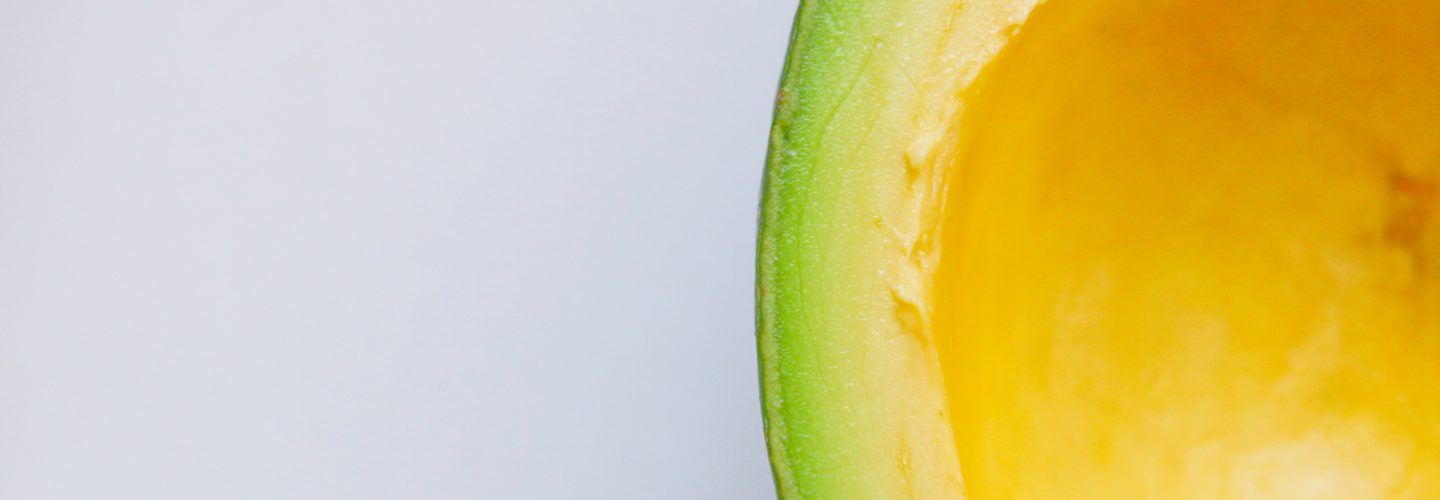
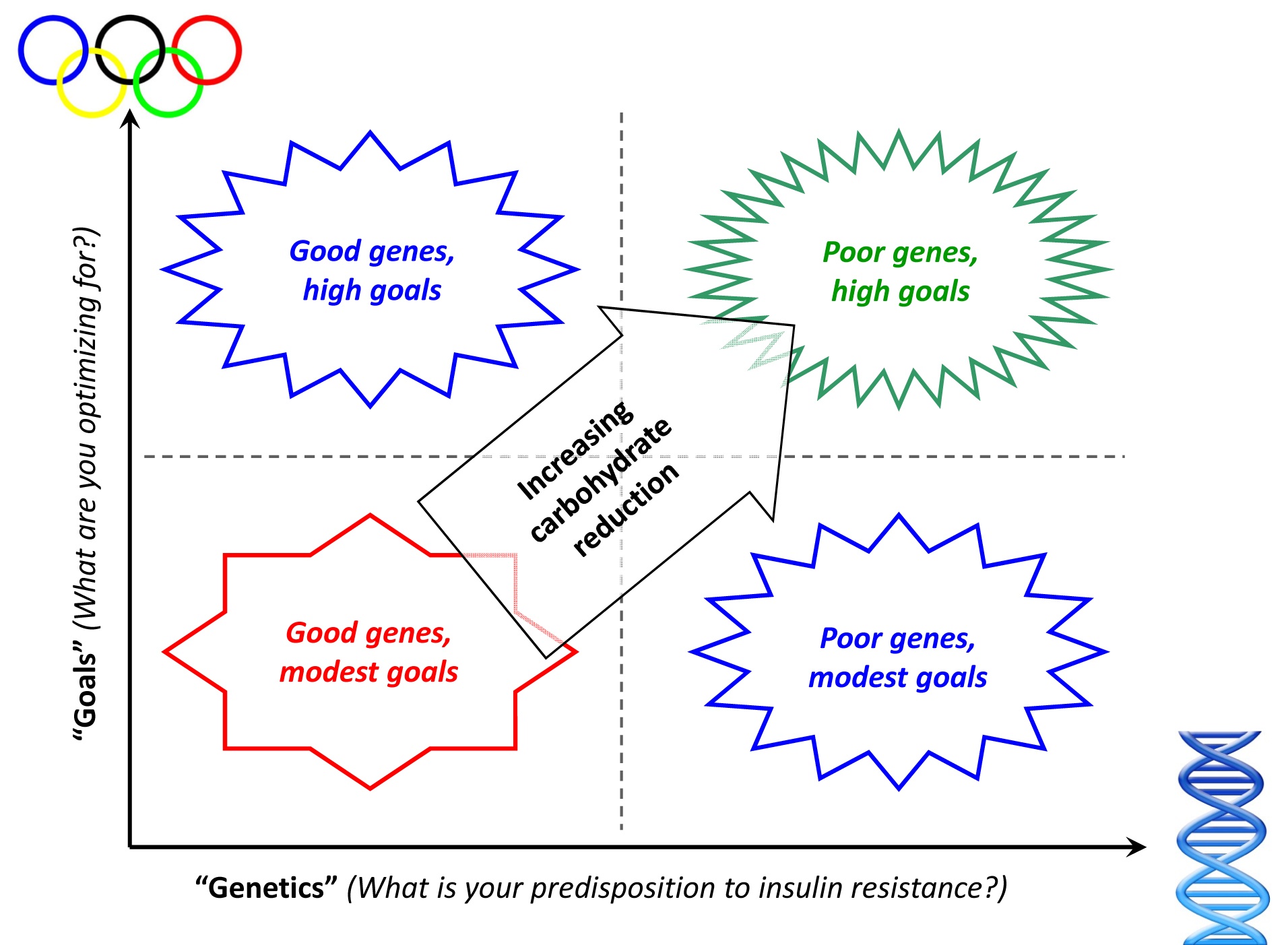

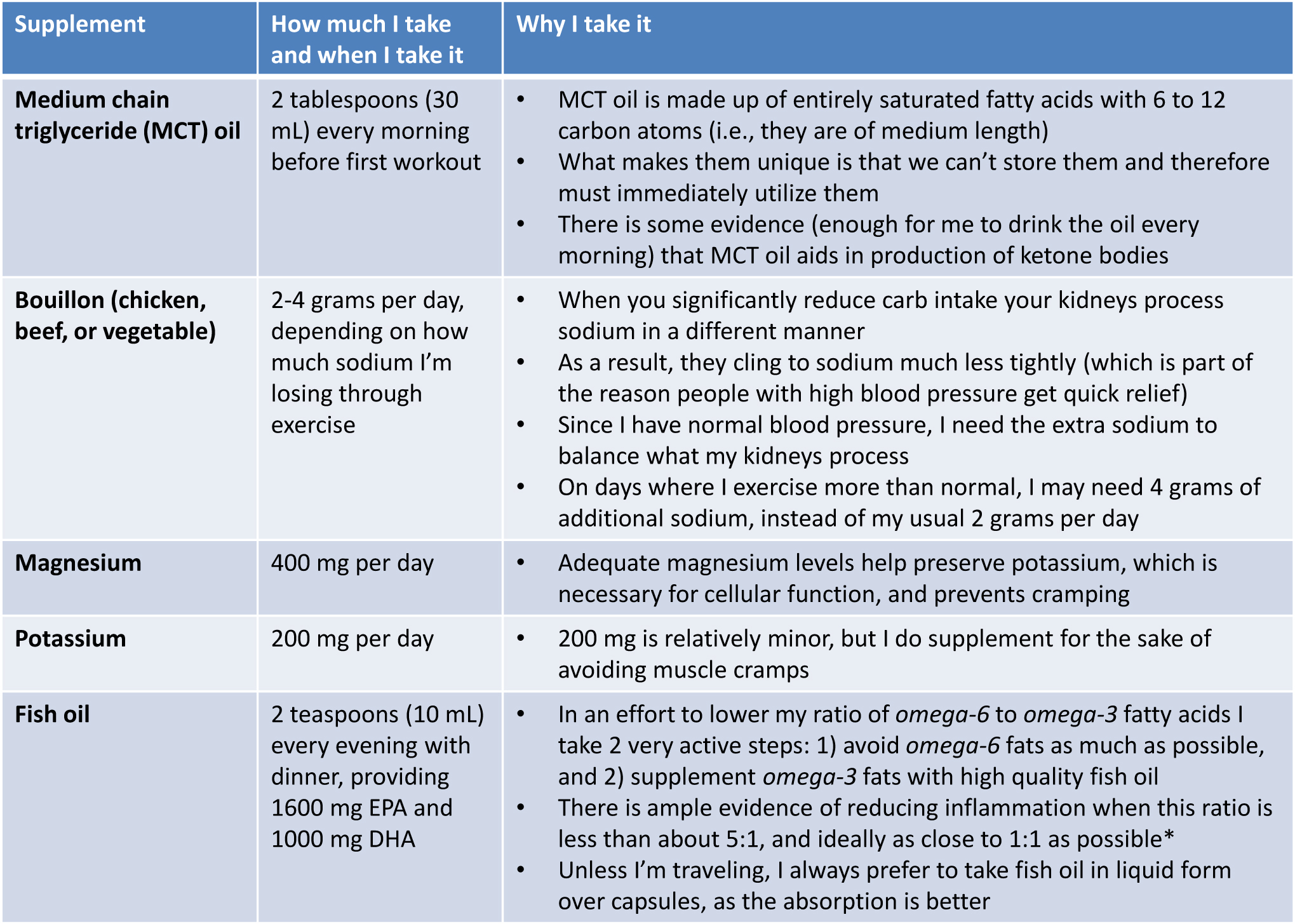

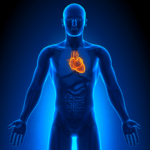
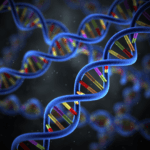
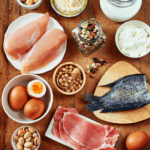
Thanks Peter; agreed re not going back and forth, but I needed to convince myself (and GP!) that the “normal” healthy eating mantra we’ve all grown up with didn’t work for me. Re your forthcoming recipes, will you collaborate? Karen Barnaby’s low carb gourmet is good – the almond puff pancakes rock!!
I haven’t really thought about it, but it could be a good idea.
Peter,
If I understand right, you supplement with sodium 2g/day generally and bump it to 4g/day on very active days. So how much sodium are you typically consuming daily prior to the supplementation? I’m trying to get a sense of optimal total sodium consumption/day.
Thanks
I get about 2-3 gm/day from food.
Hi Dr Peter.
I suspect I am in Ketosis hell. I didn’t plan to get here, I just wound up in a state of not eating carbs. I just got used to it after initially, just reducing them. It is about week 4 or so & I feel lousy. 1 course of action would be to ensure my protein levels are not too high, and increase my sodium intake, or could you just take in some carbs (above 50 grams per day) to reverse this state? Or is it not as simple as that? I also apologise because of my state I don’t have the patience reading through the site to try and find any alternative answers, nor do I really feel like weighing food. It has gotten bad when I can’t be bothered reading through your website. By the way, I love fat shakes.
See what happens when you fix the protein levels and supplement sodium. You may need to weight food if you aren’t good at accurately assessing how much you consume.
Peter,
You are clear you like to optimize your omega 3 to 6 ratio but in the list of foods you show a lot of olive oil that is high in 6. Is this balanced by the omega 3 elsewhere? Do you consider olive oil a “safe 6”? Thanks for your blog. It is so important to have someone with your background dedicated to converting the countries thinking on diet.
I do. The omega-6 I strive to avoid are the big 4: soy, canola, safflower, and sunflower. Plus, I supplement with EPA and DHA from very high quality fish oil. So my ratio of n-6 to n-3 is less than 3:1 and I’m working on getting to down to 1:1.
Peter, I notice that you drink a lot of water. Is that due to your high activity levels or is it to help flush out toxins, or other?
Thanks again for all of your quick responses to me and others.
Primarily because of exercise, but I think most people would do better to drink more than they do.
Hi, Peter,
I am enjoying reading your blog and visiting your website. I wondered what oil you use to cook with?
Also, as I’m new to it, I want to understand more about the basics of lowcarb eating, as you would recommend. I’m talking practical stuff, like lists of foods and samples of menus that expand on what you’ve written above. Can you recommend a book that you highly endorse, one that informs choices you make when, say, food shopping? I have BTW switched to Carlson’s fish oil and love it. Thanks for the recommendation.
-Joe
I only cook with butter or coconut oil. A great reference book is the recent book by Steve Phinney and Jeff Volek (it’s under my books and tools section).
Peter – I cut the protein to 150 or under and the scale started moving down again. Thanks for the tip.
After reading what you had wrote, I also then noticed it in a book by Lyle McDonald. Are you familiar with him and how do you think your philosophies match up?
I’m familiar with his book, but I don’t know him personally.
Hi Peter,
I eat a processed turkey a lot – in that case, must I still drink bouillon? I haven’t read much on the blog about the salt supplementation issue. Would an odd odor in one’s urine indicate a salt problem?
Can you also at some point address the fats in the diet issue? It is really hard for me still to just load on more fat – and yet, I’m thinking that could be what my diet is lacking. I think I’m eating plenty of fat, but perhaps not. I’m still in that old mindset where cheese is a no-no, especially since I’m always congested. But, I’m experimenting; perhaps dairy has nothing to do with my allergies. We’ll see.
Anyway, is eating cheese, for instance, in a salad okay for a meal without some animal protein as well? What if for dinner I just want eggs and cheese in a salad? (I eat only lunch and dinner, by the way. Breakfast was causing weight gain.) I’ve been assuming that I must eat a certain amount of animal protein every day. So, if you can speak to some of these issues at some point, I’d appreciate it.
Thanks so much,
Debbie
I’ll speak to these issues in future posts.
Thanks so much. This is a fantastic forum. I’ve never wanted to participate or share my food/weight experiences before. Thank you!
i tried the latte with heavy cream today, all 820 calories and 88 grams of fat.
delicious!
Hi Doctor Peter,
I notice you drink small amounts of red wine. (Obviously, this is an option added back in moderation when weight goals are met.) Is red better than white for our purposes? I thought that white had less carbs; but I think I remember Gary saying red has less sugar. Would a zero carb choice like gin, scotch, etc. be better?
Secondly, is it better to have a drink on an empty stomach or before, rather than with, dinner? I believe Gary said that your body (liver) prioritizes the alcohol, it is easy energy, and turns everything else present at the time to fat storage. It seems like a drink on its own would do less to derail ketosis and cause much less fat storage if not with food. Thank you!
Red wine (dry) is maybe 4 or 5% sugar, so a glass or two is pretty minimal in terms of sugar load. The issues with ethanol is less about the sugar (unless you’re drinking sugar drinks) and more about the actual fate of the ethanol, which mostly ends up as VLDL. Bottom line, if you’re going to drink 1) don’t drink sugary drinks, and 2) Do so in moderation to spare your liver the unceremonious task of converting it all to fat/VLDL.
To piggy back on this question — I’ve noticed very different effects of a glass of wine when I’m in ketosis and without. The other night I had just one glass of wine with dinner — a dry white. I found that I rapidly became extremely sleepy on that one glass, couldn’t stay awake beyond 10:30 pm (when I normally sleep around midnight) and woke up at 2:30 am feeling absolutely alert — my heart was beating very fast and I felt both hungry and thirsty. After tossing and turning for an hour, I gave up and researched this on the internet — it seems that insomnia is a common side-effect of drinking large amounts of alcohol, due to low blood sugar and subsequent adrenal gland activation. I wonder if this effect is exacerbated during ketosis — since my blood sugar normally doesn’t go up and down at all.
I really enjoy the “fat shakes”, and so does everybody else I make them for. I prefer blackberries myself, and I am working on a blackberry ice cream based off your wife’s infamous recipe too.
Mmmmm. Keep us posted on that one.
Thank you very much Doctor Peter, maryann
Blackberry ice cream:
– 3.5 cups heavy cream.
– 1 cup unsweetened almond milk.
– 2 cups blackberries.
– 1 tablespoon raspberry extract (or blacberry if you can find it).
– 2 tablespoons xylitol.
– 1 tablespoon stevia.
Blend before putting into the ice cream maker.
He peter really enjoy your site awesome and lots of information 🙂
Would you say that a ketonic state is the “best / natural” state for your body? Im into low carb eating but never been overweight or anything (i can eat basicly anything without putting on lots of extra weight). Still for health benefits, diseases in the future, I decided to eat healthy. I dont really have an idea on how my body responds. You say that your wife can eat more carbs, but then should you then really eat more carbs?
It looks like I dont really respond on oil.I can take 2 tableapoons of coconut oil without any increase in energy, same as i can eat lots of sugars without increase in energy (used to tank down red bull).
How can i find out what is right for my body? (self experimenting?)
Thanks 🙂
Sven
Sven, I just did an interview today that sort of touched on this point. It will be out end of the is week, or early next week. I’ll post a link to it. Short answer: there is no “best” — it’s all about tradeoffs and optimization.
Hi, Peter.
I have a question regarding MTCs and ketone bodies. I have seen mentioned (maybe here?) that MTCs can serve as a catalyst to ketosis; and I’ve seen posted elsewhere people stating that coconut oil puts them into ketosis.
I’m fairly ignorant on the subject of biochemistry, but my understanding is that MTCs are metabolized directly through the liver, and the resulting ketones aren’t a result of body fat breakdown, but from breakdown of the oil. Is this the case, and if so, would this 1) give the appearance of ketosis (positive reading on test strips) when one may not actually be metabolizing body fat, and 2) prioritize the MTC sourced ketones and therefore delay the breakdown of body fat until the ketones produced from the MTC oil is expended?
Thanks.
Also, I meant “MCT,” not “MTC.” If that wasn’t apparent. It’s Monday, and I’m a little brain dead.
Correct. MCT’s either get oxidized immediately by the liver, or excreted. The “thinking” is that it using some MCT “primes” the liver for making ketones out of endogenous fat stores.
Hi Doctor Peter,
In the Volek/Phinney book you recommended to me, on p 167-168 they discuss the temporary increase in bad cholesterol that can be expected with significant weight loss. My husband is not experiencing dramatic, sudden weight loss; he has lost 20 lbs in 6 months. His LDL went up 100 points (to 188), his triglycerides went up 40 (to 177), OxLDL/HDL is up to 57, and C-Reactive protein went up to 21. These numbers went up dramatically since they were tested only 3 months ago, when he had perhaps a 10 lb loss at the time. Is it normal to be this elevated with only a 20 lb loss? The book you recommended states that this is associated with more dramatic weight loss, of 30 lbs or more. Is this safe to sustain? If so, how long is it safe to be this way? The book says it should only last a month or two. What should we do if the numbers don’t resolve? Thank you very much, maryann
Possible, but usually TG responds very quickly. Of course, none of these numbers are particularly meaningful and the only one that really, really matters is LDL-P, but with all of them moving in the wrong direction another check is warranted soon.
LDL-P is what exactly? If the numbers stay poor, what do you think he is doing wrong in this low-carb lifestyle? Thank you, maryann
LDL-P is the number of LDL particles. If that number is poor and stays poor, it would be prudent to use medication to fix it. Many people (at least 30%, if not more) have normal LDL-C (the cholesterol number typically checked), but abnormal LDL-P. This is called discordance.
Thank you 🙂
Peter,
Can I initiate one last inquiry in this thread?
We both live in SD:
1. can you really get whole-fat Fage yogurt in town and where? I NEVER see it.
2. where do you get your grass-fed meat?
3. the foods you eat photo shows a wonderful salami (or close) – where can I get that without sugar, etc?
4. high-quality liquid fish oil; I want the best and you seem to have found it, but of which brand do you speak? (I use Carlson’s now)
5. spread the word(s)!
Thanks!
PM
I’m guessing this is not the last question on this thread, but…
1. Whole Foods is the only place I can find it.
2. I typically don’t, since I eat virtually no other omega-6, I figure I can tolerate a bit more in my steak.
3. Whole Foods, but it’s pricey.
4. Carlson’s also (this is what I use: https://www.carlsonlabs.com/p-70-very-finest-fish-oil-lemon-flavor.aspx)
It’s very easy to make your own Greek style yogurt. I make a quart every weekend.
I use 1/2 gallon of whole organic milk (organic because it’s ultra pasteurized):
1. Heat milk gently to 110 degrees F then transfer to glass bowl
2. Stir in 1/4 – 1/3 yogurt saved from the last batch (use some plain Stoneyfields or Dannon the first time)
3. Preheat the oven to 175 degrees F, then TURN IT OFF.
4. Put the bowl in the oven and leave 8 hrs (overnight)
5. When the yogurt is set, line a large colander with a dampened VERY clean tea towel and pour in the yogurt. In 2-3 hours you should have 1 quart of very thick yogurt.
I usually whisk it to get out any lumps.
TIP: I made a little magnetic sign to put on the stove that says YOGURT!! It keeps me from accidentally turning on the broiler – again. 😀
(If you don’t use ultra pasteurized milk, you must heat it to 165F – or even 185 – then let it cool.)
How do you titrate to the “right” amount to fat? This looks very cool!
“How do you titrate to the “right” amount to fat?”
That is the $64K question that I’ve been asking everyone for years! My yogurt comes out even thicker than Fage – almost like sour cream, so I’m just guessing it contains even more fat. My other big question is how much lactose is consumed by the bacteria and is there a point at which it is all consumed? Would that be after 8 hrs, or 12, or 24? Are any remaining milk sugars contained in the whey that drains out?
Does anyone happen to have some gas chromatography–mass spectrometry equipment lying around the garage?
Next up, homemade creme fraiche…
Paula, please note that you can buy full-fat Fage Total on Amazon.com. I have no idea how they deliver perishables like that, but they do.
The stores I use for things like grass-fed beef don’t have locations in South Dakota; but what you want is the type of store that sells organic and “real” foods. Maybe you have a regional chain up there.
You might see if there’s a farmer’s market in your town. Those guys usually seem to sell organicky stuff, and you might find a local rancher there who sells grass-fed meat, as well a nice stuff like pasture-eggs.
Yeah, maybe not. And it’s still Friday the 13th here (not the 14th as your server reports ie Eastern Time).
Very generous of you to answer – and I’m grateful for all (now, if only I can get my soon-to-be-fired Internal Med doctor to say something, ANYTHING, worth hearing).
Whoops, just remembered: last week I had Peet’s make me a latte w heavy cream — they didn’t want to and of course charged accordingly. Delicious!
The main problem I see (I’ve been on a low-carb paleo diet for 2 years now so no-carbs is not a problem) is how to reduce protein in a natural way (e.g. separating yolks from whites is not natural). My main source of protein and fat is meat and eggs. I honestly have no idea what the proportions of calories from protein vs fat it is and I do not want to know. I also eat coconut oil (in coffee and for cooking) and olive oil (in salads).
Would you have any tips how to establish a natural balance of protein / fat? I’ve already tried eating eating more fat (e.g. even more coconut oil in coffee and even more olive oil in salad) hoping that I would naturally start eating a bit less of meat but I’d rather not count how much grams of protein vs fat my steak contains in order to reduce the former.
Martin, this protein problem is sort of unique to folks like me who eat an enormous number of total calories. If I eat just 3 eggs, for example, I don’t need to do this. It’s only when I’m eating 8 eggs, that I’ll remove some whites.
Hi Peter! Just listened to your interview on Ben Greenfields site and really enjoyed it!
Was wondering if you recommend a supplement brand for sodium chloride. Would it
be best to take supplements if we didn’t want to drink bouillon?
Thanks!
I just use bouillon or heavy duty salt tabs, but much prefer bouillon.